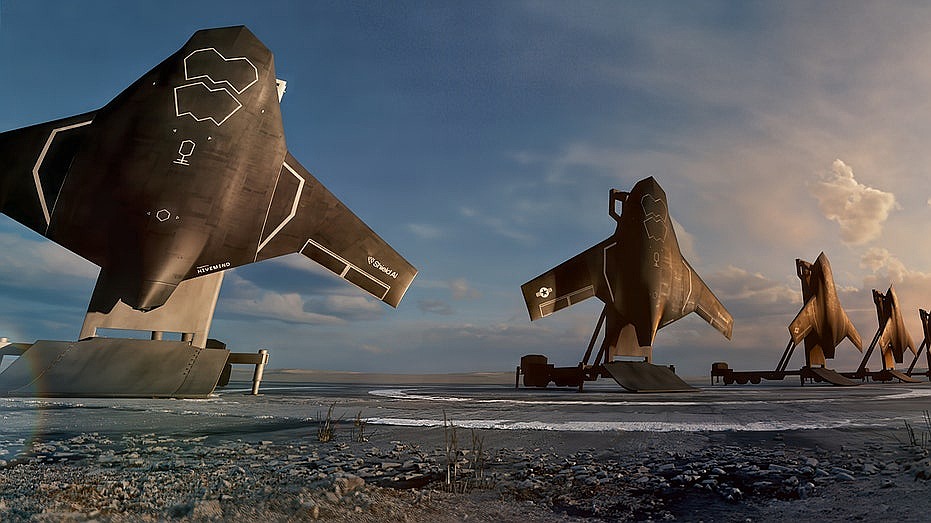America’s ‘BAT’ man unveils tech built to outsmart a Chinese first strike
In a rapidly evolving military landscape, analysts have identified a concerning strategy employed by China in its potential conflict with the United States: targeting American fighter jets before they can even take off. This tactic has historical precedence, as seen in various modern conflicts where disabling enemy aircraft on the ground has been a key initial move. For instance, Israel’s recent strikes on Iranian nuclear sites began with the destruction of runways, effectively grounding Iran’s air force. Similarly, both Russia and Ukraine have focused on airfield attacks to cripple each other’s aerial capabilities. China has taken these lessons to heart, developing an extensive arsenal of long-range precision missiles, such as the DF-21D and DF-26, designed to strike U.S. airfields and aircraft carriers across the Pacific, thereby keeping American air power at bay.
In response to this emerging threat, U.S. defense technology firm Shield AI has unveiled a groundbreaking solution: the X-BAT, an AI-piloted fighter jet capable of vertical takeoff and landing (VTOL) and operating autonomously without the need for runways or GPS. This innovative aircraft can reach altitudes of 50,000 feet and cover over 2,000 nautical miles, executing both strike and air defense missions using its advanced Hivemind autonomy system. The X-BAT’s ability to operate from unconventional locations, such as ships or small islands, makes it a formidable asset in a combat scenario where traditional jets may be vulnerable on the ground. As Shield AI’s senior vice president of aircraft engineering, Armor Harris, notes, the focus is on mobility to counteract the “anti-access aerial denial bubble” created by China. The X-BAT’s compact design allows three units to occupy the space of a single legacy fighter, significantly enhancing operational flexibility.
The X-BAT is expected to be combat-ready by 2029, delivering performance comparable to fifth- or sixth-generation fighters at a fraction of the cost of manned aircraft. Shield AI aims to produce the X-BAT affordably, breaking the traditional “fighter cost curve” and providing an estimated tenfold improvement in cost per effect compared to legacy jets like the F-35. With discussions underway with both the U.S. Air Force and Navy for integration into future combat programs, the X-BAT represents a shift towards distributed airpower, reminiscent of the transformation SpaceX brought to the space industry. Harris emphasizes that while manned platforms will continue to play a vital role, unmanned systems like the X-BAT will increasingly dominate the battlefield, restoring deterrence through enhanced flexibility and creating a significant challenge for adversaries like China.
Related articles:
– Link 1
– Link 2
Analysts say China has developed a chilling strategy for fighting a war with the United States: destroy America’s fighter jets before they ever leave the ground.
In nearly every modern conflict, disabling enemy aircraft on the ground has been the first move. When Israel struck Iranian nuclear sites earlier this year, it began by destroying Iranian runways — grounding Tehran’s air force before it could take off. Russia and Ukraine have done the same throughout their ongoing war, targeting airfields to cripple enemy aircraft. And when India clashed with Pakistan, the opening salvos hit Pakistani air bases.
Beijing has taken that lesson to heart. The
People’s Liberation Army (PLA)
has spent years building an arsenal of long-range precision missiles — including “carrier killers” like the DF-21D and DF-26 — capable of destroying U.S. aircraft carriers and striking American airfields across the Pacific. The goal: keep U.S. air power out of range before it can even launch.
ISRAEL TO DEPLOY FIRST COMBAT-READY LASER WEAPON SYSTEM FOR OPERATIONAL AIR DEFENSE
Now, a U.S. defense technology firm says it has built a way to fight back. Shield AI, based in San Diego, has unveiled a new AI-piloted fighter jet designed to operate without runways, without GPS, and without constant communication links — an aircraft that can think, fly, and fight on its own.
Shield AI says the jet, called X-BAT, can take off vertically, reach 50,000 feet, fly more than 2,000 nautical miles, and execute strike or air defense missions using an onboard autonomy system known as Hivemind. It’s designed to operate from ships, small islands, or improvised sites — places where traditional jets can’t. The aircraft’s dash speed remains classified.
“China has built this anti-access aerial denial bubble that holds our runways at risk,” said Armor Harris, Shield AI’s senior vice president of aircraft engineering, in an interview with Fox News. “They’ve basically said, ‘We’re not going to compete stealth-on-stealth in the air — we’ll target your aircraft before they even get off the ground.’”
The jet launches vertically, and three X-BATs can fit in the space of one legacy fighter or helicopter.
According to Harris, the U.S. has spent decades perfecting stealth and survivability in the air while leaving its forces vulnerable on the ground. “The way to solve that problem is mobility,” he said. “You’re always moving around. This is the only VTOL fighter being built today.”
X-BAT’s Hivemind autonomy allows it to operate in denied or jammed environments, where traditional aircraft would be blind. The system uses onboard sensors to interpret its surroundings, reroute around threats, and identify targets in real time. “It’s reading and reacting to the situation around it,” Harris said. “It’s not flying a pre-programmed route. If new threats appear, it can reroute itself or identify targets and then ask a human for permission to engage.”
That human element, he emphasized, remains essential. “It’s very important to us that a human is always involved in making the use of lethal force decision,” Harris said. “That doesn’t mean the person has to be in the cockpit — it could be remote or delegated through tasking — but there will always be a human decision-maker.”
Shield AI says X-BAT will be combat-ready by 2029 and is designed to deliver fifth- or sixth-generation performance at a small fraction of the cost of manned fighters. The aircraft’s compact footprint allows up to three X-BATs to fit in the deck space of a single legacy fighter or helicopter, giving commanders more flexibility in launching sorties from limited space.
AMERICA’S NEW STEALTH B-21 RAIDER TAKES NEXT STEP WITH SECOND BOMBER’S FIRST FLIGHT
While Shield AI isn’t disclosing specific numbers, the company says X-BAT is priced in the same range as the Air Force’s Collaborative Combat Aircraft (CCA) program, the next generation of
autonomous wingmen
meant to fly alongside — and eventually ahead of — manned fighters. Costs vary depending on mission systems and configurations, but the company’s goal is to scale production to keep the jet affordable and sustainable throughout its lifecycle, breaking what it calls the traditional “fighter cost curve.”
The company estimates the aircraft will deliver about a tenfold improvement in cost per effect compared to legacy fifth-generation jets, including the F-35, while remaining “affordable and attritable” enough to be risked in high-end combat.
Shield AI is in discussions with both the Air Force and Navy about integrating X-BAT into future combat programs and with several allied militaries exploring joint development opportunities.
Harris said the company views X-BAT as part of a generational shift toward distributed airpower — one that mirrors what SpaceX did in space. “Historically, the United States had a small number of extremely capable, extremely expensive satellites,” he said. “Then you had SpaceX come along and put up hundreds of smaller, cheaper ones. The same thing is happening in air power. There’s always going to be a role for manned platforms, but over time, unmanned systems will outnumber them ten-to-one or twenty-to-one.”
For Harris, that shift is about
restoring deterrence
through flexibility. “X-BAT presents an asymmetric dilemma to an adversary like China,” he said. “They don’t know where it’s coming from, and the cost of countering it is high. It’s an important part of a broader joint force that becomes significantly more lethal.
Eric
Eric is a seasoned journalist covering US Politics news.



